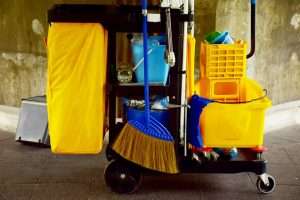Killing Germs, Pathogens, and Microorganisms – What Your Cleaning Company Should Know
One of the main things that you will have to do as a cleaning service is to ensure that you are killing germs, pathogens, and microorganisms. There can be various nooks and crannies hidden throughout the area that can hide bacteria and viruses. This includes the toilet seat to the microwave’s door handle. These bacteria and viruses hitch on hands and spread far and wide. By understanding how disinfectants work, you will be able to choose the right solution to effectively control the harmful microorganisms that are multiplying inside of your building.
How do they work, you ask?
Disinfectant work by putting oxygen into the germs which effectively breakthrough their cell walls. This can completely disrupt the germs and cause them to break down. Because there are various ingredients and combinations of ingredients that kill off various germs, you will need to find the right disinfectant that destroys the type of germs you are looking to get rid of. If you cannot do this, you will want something that is considered broad-spectrum which implies it will work on a range of different germs.

There are a variety of different disinfectants that you can choose from. Some of the ones that a specialized cleaning company needs to be aware of are as follows:
Quaternary Disinfectants
These are the types of disinfectants that carry a positive charge. This works well because various germs, bacteria, and viruses you are looking to get rid of carrying the opposite. Thus, when you use this disinfectant on a surface, you will be able to alter the cells of whatever microorganism is present to a negative charge which effectively kills it.
Quaternary is typically what is found and used in some of the low-level situations for sanitizations. These disinfectants are typically lacking odour and they are non-staining and non-corrosive which means they can be used with metal. Along with this, they have the benefit of being non-toxic when used properly.
Phenolic Disinfectants
These are the disinfectants that have phenol and phenolics as the active ingredients. This is usually what you will find in some of the market-ready household cleaners. These are some of the oldest disinfectants. However, phenol has the downside of being bad for the skin. Thus, you should opt for phenolic instead which is far less corrosive to the skin.
These ingredients are very effective at both disinfecting and sanitizing. Along with this, they are even effective at getting rid of various types of bacteria including that which is known to result in tuberculosis. These disinfectants can be rather expensive to use and they can cause fairly significant reactions when used on plastic.

To ensure that you are using the right kind of disinfectant for the right situation you should be looking at several factors.
Concentration
One of the most important things is paying attention to the concentration you are using. You will need to dilute the disinfectant for maximum effectiveness and safety.
Contact Time
Some disinfectants will need to make contact with the germs they are supposed to kill for a specified period. Thus, you want to ensure they are left there long enough to be effective.
pH
Some disinfectants require acidic conditions, and some require alkaline conditions for maximum effectiveness.
Temperature
You will find some work better with cold water and some will be better with warmer water. Bleach is one that works best with cold water.
There are a lot of different products available in the marketplace that are effectively made to get rid of the spread of germs and bacteria. Some are even capable of removing them from the most commonly touched surfaces. How are you able to tell which products can kill which germs? By reading the label of the cleaning product, you should be able to find the EPA number. All disinfectants sold commercially must have registered effectiveness claims with the EPA.
Because every disinfectant is designed to kill off harmful microorganisms, you will need to follow the instructions for maximum effectiveness. You must make contact with the germs you are looking to get rid of. Thus, you will need to clean the surface before using any disinfectant to ensure it is coming into direct contact with the germs.
Even though you can remove a lot of grime and dirt with surface cleaning, a lot of the germs and bacteria you leave behind can multiply. By using the right disinfectant and using it the right way, you should be able to keep your building as healthy as possible. For all of your commercial cleaning needs in the GTA contact us!


